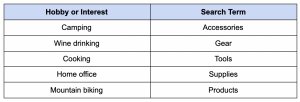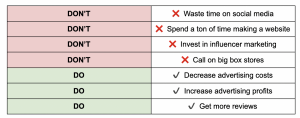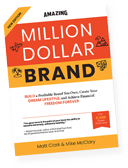How to Start a Business on Amazon | Step-by-Step Guide to Amazon FBA
Starting your own business is fun, scary, and smart. Especially if you’re using the proven Amazon FBA business model. So if you’re ready to take the plunge into unlimited earning potential, here are the steps to get started.
#1: Set up your account
First thing’s first, set up your Amazon selling account. If you already have a selling account, all you have to do is log in and add Fulfillment by Amazon (FBA).
If you don’t have a selling account with Amazon yet, you can sign up for one online. You’ll be prompted to choose a selling plan, either individual or professional. You’ll also need info like:
• Business email address
• Government ID
• Tax information
• Phone number
• Bank account information
When you’ve got an Amazon selling account set up, and you’ve signed up for FBA, it’s time to move on to the next step.
#2: Pick your product
Next up, research your market like there’s no tomorrow. The key is identifying a product that other sellers don’t offer. Here are some ways to get started:
Get a browser extension
Use tools like Jungle Scout or Unicorn Smasher to scour Amazon. These data analyzers pick up data and organize it into an easy-to-understand dashboard. This helps you research competitors, categories, products, and more.
Start with your interests and passions
Think about things you like to do and know a lot about — and make a list. For example, maybe you like to camp on the weekends. Then, head over to Amazon and run a search for each interest on your list and a search term like “accessories.” Here are some examples:

Pull one term from the left, and one term from the right. Search through Amazon and bookmark products you can picture yourself using in real life. Then run each one through the starter product checklist.
Search through BSR categories
BSR, or Best Sellers Rank, is an Amazon label that highlights in-demand products. You can use this orange BSR label to your advantage with some quick searches.
In short, BSRs show that a product, or a niche, is popular. Find a product or niche that has at least one BSR. Then narrow and broaden your search until you find multiple BSRs in the same category. Run those products through the starter product checklist to make sure it’s a viable product.
The starter product checklist
Narrow down your search through a baseline metrics comparison. When you think you’ve found the ultimate product to sell, ask yourself if it checks all these boxes:
- Good profit potential – Your product can bring in between $10k and $25k each month.
- Not too competitive – There are fewer than 1k reviews on Amazon.
- Low inventory investment – Your product sells for a price somewhere between $17 and $100 each.
If your product checks all these boxes, chances are you’ve found a winner. And now that you’ve chosen a product, the hard part’s over. Next up is getting it on Amazon. There are a couple of parts to this.
Find a supplier
Most Amazon FBA business owners work with suppliers in China. They’re one of the world’s top manufacturers and you just can’t beat their prices. But how do you find a supplier overseas? And how do you know if they’re legit? Use this checklist to find and vet manufacturers in China:
• Check online marketplaces like Alibaba or JimTrade
• Visit trade shows to talk with suppliers one-on-one
• If you have the extra cash, work with a product sourcing agency
• Make sure they’re used to working with private label brands
• Talk with your supplier before shipment to make sure packaging lines up with Amazon FBA guidelines
Once you’ve found a quality supplier, use these steps to get your product made:
• Verify you can make a profit
• Make at least one improvement to the product. Look through other product reviews for ideas on which improvements to make
• Order some samples
• Place your order and have it delivered to an Amazon warehouse
#3: Launch your product
Here’s the fun part — launching your product. Come up with a clear name for your brand, and a logo and product description. The more complete your Amazon listing is, the better.
Remember, you have the advantage here as a native English speaker. Lots of sellers on Amazon are overseas, but most of Amazon’s customers are in North America. Take your time to write a product description that’s compelling — and optimize it for search terms. Here are some additional tips for the perfect product page:
• Put your primary keyword toward the beginning of the description
• Focus on the benefits of your products
• Get at least 5 to 10 reviews
• Get high-quality images
Some sellers choose to use stock photographs from the supplier. But all you need is a smartphone camera, a ring light or two, and some basic photo tips to take next-level images. Plus, if you use your own photos, you’ll stand out against any other sellers with the same product.
Before you start selling out every month, you need to get your hands on the first few positive reviews. Ask your friends, ask your family, and post on social media about your new product.
You can also temporarily lower your prices to entice new buyers. Then encourage them to leave detailed, positive reviews. Once you’ve got a handful of 5-star posts, you can start raising your prices to earn a profit. But before then, you have to get people to notice your product. Reviews help. Social media helps. And sponsored product listings help, too. You can also:
• Create compelling coupons
• Launch a manual advertising campaign
• Drive sales through cash-back offers
#4: Grow your sales
You’ve got your product. You’re earning revenue. Now it’s time to start growing your sales. Here are six guidelines to follow when you’re to take the next step:

Even though your brand is important, it’s critical you don’t spend time on the wrong activities. Things like social media, designing a high-tech website, or spending tons of money on influencers waste precious resources.
Instead, invest your time and money in smarter advertising. Amazon shows you exactly what you need to do:
• Amazon tells you which keywords are wasting ad spend
• Remove the keywords that aren’t working for you (add them as negative keywords)
• Amazon also tells you which keywords are making you money
• Click “Add as keyword” under your search terms menu in Amazon to start making more money
• Use Amazon’s “Request a Review” function to encourage buyers who’ve recently ordered from you
#5: Expand your brand
Now that your starter product is up, running, and raking in the cash, it’s time to start expanding. Get ready to add two additional products that’ll skyrocket revenue.

First, research a growth product. It’ll have the same price range as your starter product, but it’ll have higher earning potential.
Then, research a dream product. It can be any price, as long as it’s above $17. And it has unlimited earning potential.
These three products work together as your brand. Each has a different price point and revenue bracket. And each tier supports a diverse, robust brand that’s designed to make you some serious money. Repeat steps two through four to launch your growth product and your dream product.
Flywheel marketing (cross-selling)
Once all three products are launched on Amazon, switch gears and focus on cross-selling (also known as flywheel marketing). This practice exposes customers to all your products while they shop online, even if they weren’t searching for them. You can do this through:
• Virtual bundles
• Product ads
• Promotions
For example, let’s say your starter product is tents. Your growth product is blow-up mattresses. And your dream product is a portable camping grill. When a shopper searches for and finds your blow-up mattress, you show them your other products, too. You suggest that they might also need a tent or a portable grill to cook food.
Flywheel marketing encourages shoppers to buy multiple products from your line to save money or complete a set. In short, you lead customers through their shopping journey. And at each step along the journey, you show them what you offer and why your products are valuable. Let’s call this a rotation.
With enough rotations, the flywheel starts to turn itself — generating sales, new leads, and more orders along the way.
Final thoughts
That’s it. Five easy steps to build a profitable Amazon FBA business. It takes some work and upfront investment. But it’ll pay off if you do it right. Check out our FREE four-part training for even more information about starting your FBA business from scratch, step-by-step.
The video training series covers finding opportunities on Amazon, creating the perfect listing, getting your first customers, and more. Check it out now and register online for free. And when you sign up online, you’ll get 3 FREE BONUSES! We’ll show you what to sell and how to make your first sales — even if this is your first business ever.
Find your first--or next--product to sell fast
Discover top-selling products on Amazon. See accurate sales trends and profit estimates so your next product succeeds. Plus, plan out your entire product and brand with a new custom AI tool unavailable anywhere else.
Heading 1
with a request body that specifies how to map the columns of your import file to the associated CRM properties in HubSpot.... In the request JSON, define the import file details, including mapping the spreadsheet's columns to HubSpot data. Your request JSON should include the following fields:... entry for each column.


